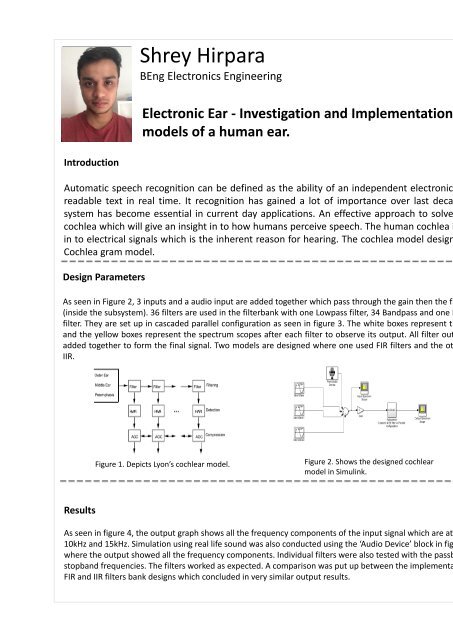UWE Bristol Engineering showcase 2015
Create successful ePaper yourself
Turn your PDF publications into a flip-book with our unique Google optimized e-Paper software.
Shrey Hirpara<br />
BEng Electronics <strong>Engineering</strong><br />
Project Supervisor<br />
Mokhtar Nibouche<br />
Electronic Ear - Investigation and Implementation of computational<br />
models of a human ear.<br />
Introduction<br />
Automatic speech recognition can be defined as the ability of an independent electronic system to translate a spoken language into a<br />
readable text in real time. It recognition has gained a lot of importance over last decade The need for efficient speech recognition<br />
system has become essential in current day applications. An effective approach to solve this problem would be to model the human<br />
cochlea which will give an insight in to how humans perceive speech. The human cochlea is responsible for converting the sound energy<br />
in to electrical signals which is the inherent reason for hearing. The cochlea model designed in this investigation is based on the Lyon's<br />
Cochlea gram model.<br />
Design Parameters<br />
As seen in Figure 2, 3 inputs and a audio input are added together which pass through the gain then the filterbank<br />
(inside the subsystem). 36 filters are used in the filterbank with one Lowpass filter, 34 Bandpass and one Highpass<br />
filter. They are set up in cascaded parallel configuration as seen in figure 3. The white boxes represent the filters<br />
and the yellow boxes represent the spectrum scopes after each filter to observe its output. All filter outputs are<br />
added together to form the final signal. Two models are designed where one used FIR filters and the other uses<br />
IIR.<br />
Results<br />
Figure 1. Depicts Lyon’s cochlear model.<br />
Figure 2. Shows the designed cochlear<br />
model in Simulink.<br />
As seen in figure 4, the output graph shows all the frequency components of the input signal which are at 1kHz,<br />
10kHz and 15kHz. Simulation using real life sound was also conducted using the ‘Audio Device’ block in figure 2,<br />
where the output showed all the frequency components. Individual filters were also tested with the passband and<br />
stopband frequencies. The filters worked as expected. A comparison was put up between the implementation of<br />
FIR and IIR filters bank designs which concluded in very similar output results.<br />
Figure 3. Depicts the filterbank inside the<br />
subsystem..<br />
Figure 4. Shows the output signal<br />
using the spectrum scope.<br />
Project summary<br />
This thesis is targeted at designing and implementing<br />
a software electronic model of the human ear.<br />
Initially, the human ear is studied along with all its<br />
functions. Two effective computational ear models,<br />
Lyon’s and Patterson’s are investigated while Lyon’s<br />
model is chosen to design the ear model. The<br />
software simulations are done using Simulink. Since<br />
the human ear has the audible range of 20Hz to<br />
20kHz, the total frequency range in the model is also<br />
the same. The segregation of the frequency bands<br />
among the filters are divided according to the<br />
sensitivity of the human ear.<br />
Project Objectives<br />
• Study of the human auditory system which is the<br />
root of this research.<br />
• Investigate the existing achieved auditory<br />
research and learn the Lyon’s auditory model.<br />
• Design the cochlea gram based on cascade only<br />
Lyon’s cochlear model on Simulink.<br />
• Validation of various components of the design<br />
under different conditions such as:<br />
‣ Response to human speech: Human ear has better<br />
sensitivity to speech when compared to other<br />
frequencies. This test will help in test it.<br />
‣ Response to the entire hearing spectrum<br />
‣ Response to frequencies outside the hearing<br />
spectrum<br />
Project Conclusion<br />
The anatomy of human ear was analyzed. Various<br />
filter designs such as FIR, IIR and their<br />
implementations were studied by simulating on<br />
Simulink and understanding the responses. The<br />
spread factor was derived such that the response of<br />
one filter does not affect the response of other filters<br />
because all of them are mutually coupled. The<br />
completed design was then subjected a number of<br />
tests across all the corners of the input spectrum. The<br />
results obtained matched the understanding of the<br />
Lyon’s cochlea model.


